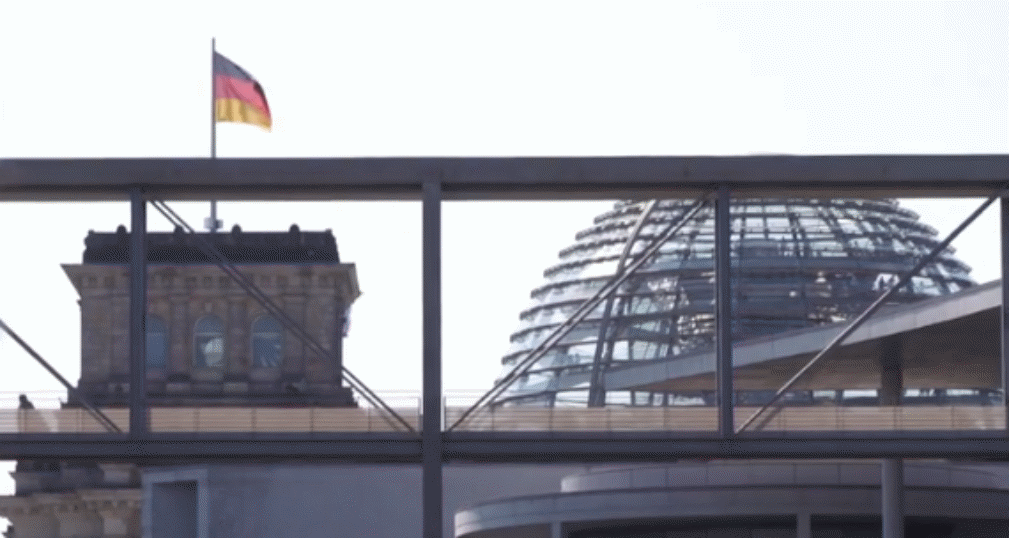By Michael Roberts
Today, elections take place in two large provincial states (Länder) in eastern Germany. All the opinion polls show that the Eurosceptic, anti-immigrant, Russia-friendly parties of both the extreme right and the new left are ahead. The parties of the current Federal coalition of the Social Democrats, Greens and the so-called Free Democrats are being decimated to the point of non-existence in these states of the former East Germany.
The three eastern states combined are home to around 8.5 million people, making up 10 per cent of Germany’s population. But it is not just in these states that the ‘centre’ of German politics is collapsing. The three parties in Chancellor Scholz’s coalition government have seen their combined share of the vote fall from over 50 per cent at the end of 2021, to less than a third today.
Threat from the far right AfD party
In these Länder elections, the right-wing islamophobic Alternative for Deutschland (AfD) party is expected to poll over 30% share in Thuringia and Saxony, with the prospect of winning power in the former. Bjorn Höcke, who has already been convicted twice for using prohibited Nazi slogans, is the leader of the AfD in Thuringia. But also a new left-wing party, with its eponymous name the Sahra Wagenknecht Alliance (BSW), is expected to take up to 15-20% of the vote.
Germany is dealing with a spike in immigration as the number of asylum applications reached 334,000 in 2023. A recent poll found 56 per cent of Germans said they feared they could be overwhelmed by immigration. So it would appear that immigration and racism are the drivers of the rise of the extreme right AfD. But the irony is that the AfD vote improved mainly in areas in Eastern Germany where immigration was relatively low –it is the fear rather than the reality that drives such prejudice and reaction.
After all, Germans are used to immigrants. Germany is the second most popular migration destination in the world, after the US. Over one out of five Germans has at least partial roots outside of the country, or about 18.6m. But the question of immigration became a huge issue in Germany because of the disaster in the Middle East and Ukraine leading to a massive and fast influx of refugees, around 2m in the last two years into Germany. Most of these refugees were placed in the poorest parts of eastern Germany, already under the pressure of poorer housing, education and social services.
Right wing leaders are representatives of capital
The other irony is that the co-leader of the AfD is no poor populist of the people, but instead Alice Weidel is a former economist at Goldman Sachs and financial consultant – shades of the UK’s Reform ‘populist’ leader Nigel Farage, who is a stockbroker. These representatives of capital have no connection with their rank and file voters, but attempt to rise to power on prejudice and mendacity. The phenomena of ‘populist’ right-wing nationalist parties is not confined to Germany. In France there is the National Rally, in the UK the Reform party and in Italy we have the Brothers of Italy actually in power. Indeed in nearly all EU states, there are parties of reaction polling around 10-15% of the vote as the recent EU Assembly elections confirmed.
For me, all this is a product of the Long Depression in the major capitalist economies since the end of the Great Recession of 2008-9, which has hit the poorest and least organised of the working class, along with small businesses and self-employed. They have turned to ‘nationalism’ for an answer, thinking that the causes of their demise are immigrants, handouts to other EU countries and big business – in that order.
The situation has deteriorated most in Germany because of the after effects of the pandemic slump and the Ukraine war. The great manufacturing powerhouse of Europe, Germany, has ground to halt since the pandemic. And the votes for the traditional parties have dived with it.
The demise of the German economy
The demise of the German economy has exposed the underlying issue of a ‘dual labour’ market with a whole layer of part-time temporary employees for German business on very low wages. About one quarter of the German workforce now receive a “low income” wage, using a common definition of one that is less than two-thirds of the median, which is a higher proportion than all 17 European countries, except Lithuania. This cheap labour, concentrated in the eastern part of Germany, is in direct competition with the huge numbers of refugees arriving in the last two years. So many voters of eastern German think that the problem is immigration.
But beneath that is the deterioration of the German economy, particularly affecting the east. Germany is the EU’s most populous state and its economic powerhouse, accounting for over 20% of the bloc’s GDP. Manufacturing still accounts for 23% of the German economy, compared to 12% in the US and 10% in the UK. And manufacturing employs 19% of the German workforce, as opposed to 10% in the US and 9% in the UK.]
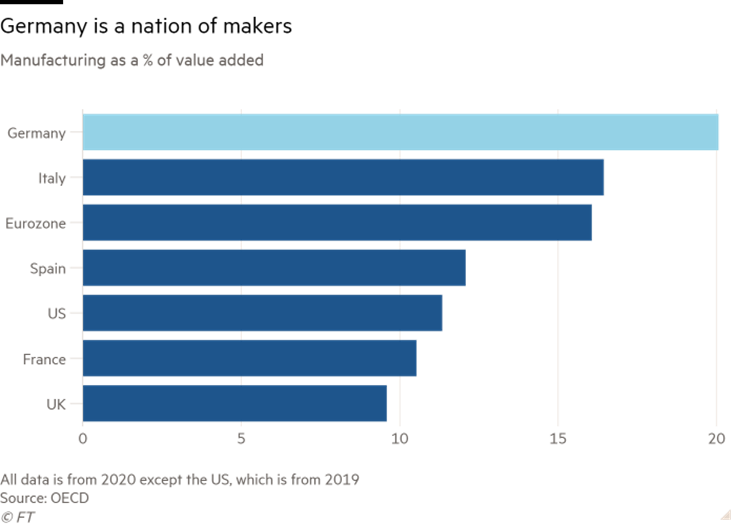
But this largest economy in Europe is in recession. Real GDP in the second quarter of 2024 was down 0.1% compared to the first quarter of 2024 and down the same amount compared to Q2 2023. Indeed, German real GDP has shown no growth for five consecutive quarters and has really stagnated for the last four years.
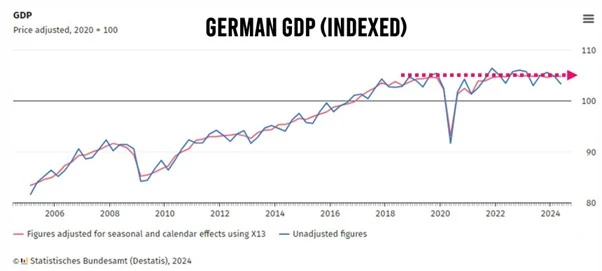
The German government has followed slavishly the policies of the Western NATO alliance and ended its reliance on cheap energy from Russia – indeed it even went along with the blowing up of the vital Nordstream gas pipeline. Energy costs have rocketed for German households.
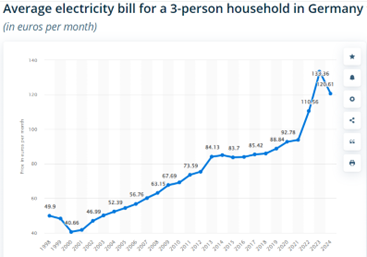
Indeed, real wages in Germany are still below pre-pandemic levels, as they are in many EU countries.
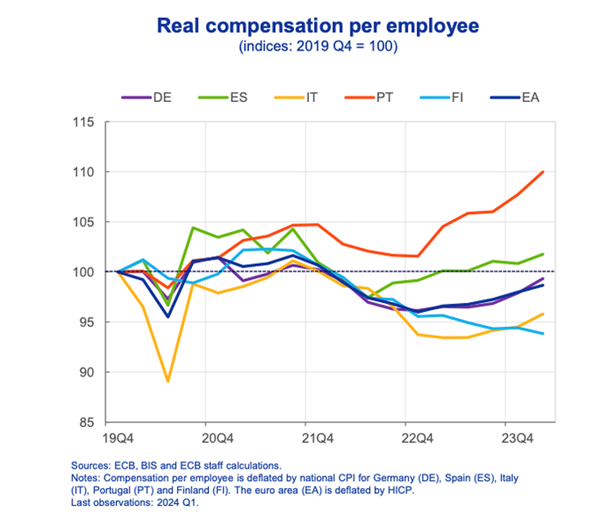
Impact of rising energy costs on the economy
But more important for German capital are the rising energy costs for manufacturers. The German Chamber of Industry and Commerce (DIHK) comments: “The high energy prices also affect companies’ investment activities and thus their ability to innovate. More than a third of industrial companies say that they are currently able to invest less in core operational processes due to the high energy prices. A quarter say they can engage in climate protection with fewer resources, and a fifth of industrial companies have to postpone investments in research and innovation.” “In addition to the planned relocation of production, this represents another acute threat to Germany as an industrial location,” warns Achim Dercks (DIHK). “If companies themselves no longer invest in their core processes, this will amount to a gradual dismantling.”
Last summer, the IMF reckoned that these rising costs would reduce Germany’s potential economic growth by up to 1.25% a year, “depending on the ultimate
magnitude of the energy price shock and the degree to which increased energy efficiency can mitigate it.”
In the last three years, manufacturing activity has collapsed.
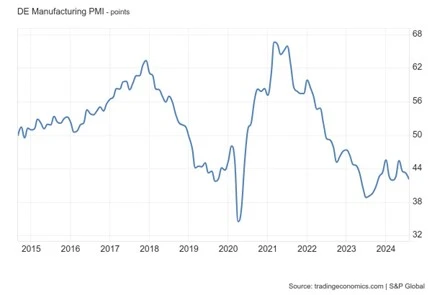
Big drop in profitability
Also, the profitability revival for German capital from the beginning of the euro, the relocation of industrial capacity into the east of the EU and low wages for a large part of the labour force is over. The profitability of German capital began to fall in the Great Recession and through the Long Depression of the 2010s. But the biggest drop came in the pandemic and profitability is now at an historic low.
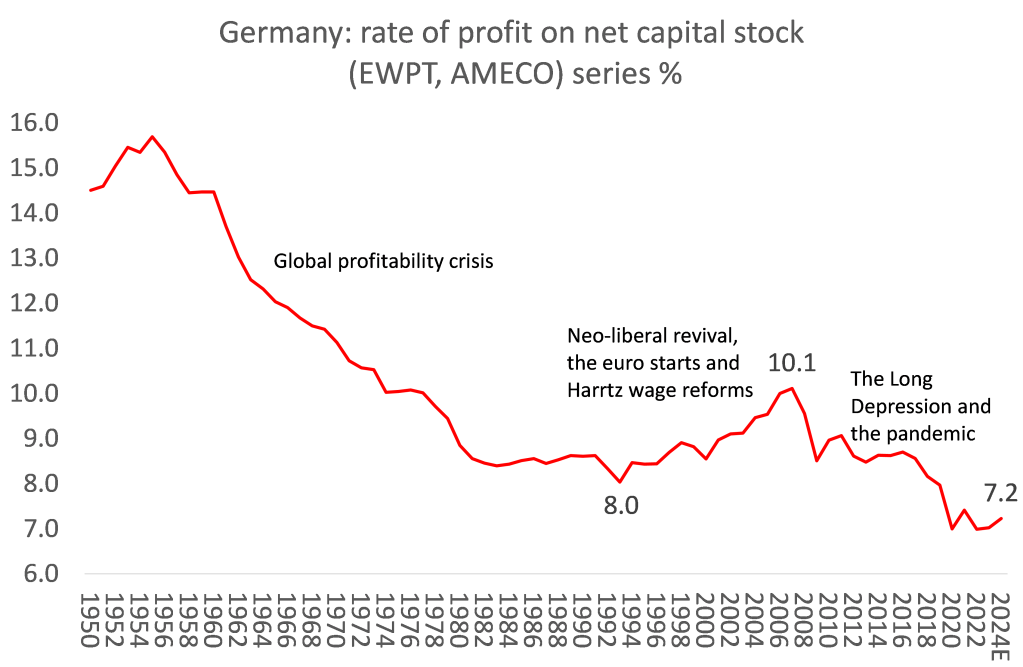
Worse, the mass of profits has also started to fall as the rising costs of production (energy, transport, components) eat into revenues. And when total profits fall, a collapse in investment and recession will follow.
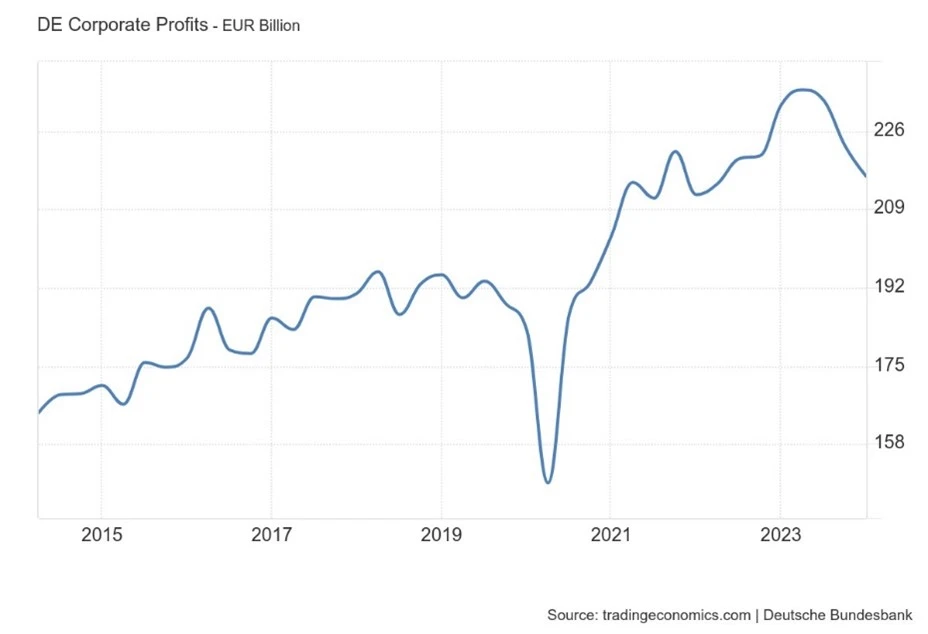
Gross capital formation (a proxy for investment) is contracting.
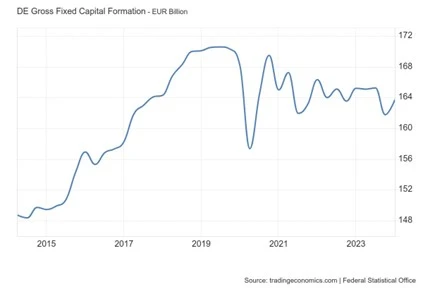
The causes of Germany’s demise
This brings me to the arguments being put forward by Keynesian economists that Germany’s demise is due to a lack of consumer demand and ‘overcapacity’ in production. It is argued that Germany’s large trade surplus (exports over imports) shows an ‘imbalance’ in the economy that should be rectified by increasing consumption.
But this is nonsense. If we look at the components of German real GDP since the start of the pandemic slump in 2020, we can see that Germany’s slump was not the result of a slump in consumption (up 1%), but in investment. Falling profitability and profits led to falling investment (down 7%).
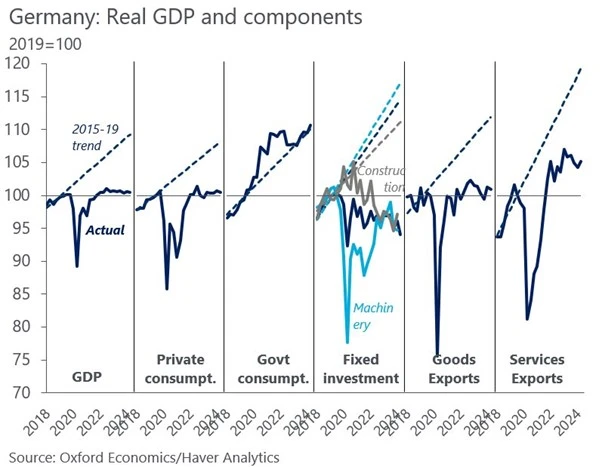
Also Germany is not ‘flooding’ the world with its exports in consequence. The trade surplus with the rest of the world is pretty much unchanged at E20bn a year as in the years of the 2010s.
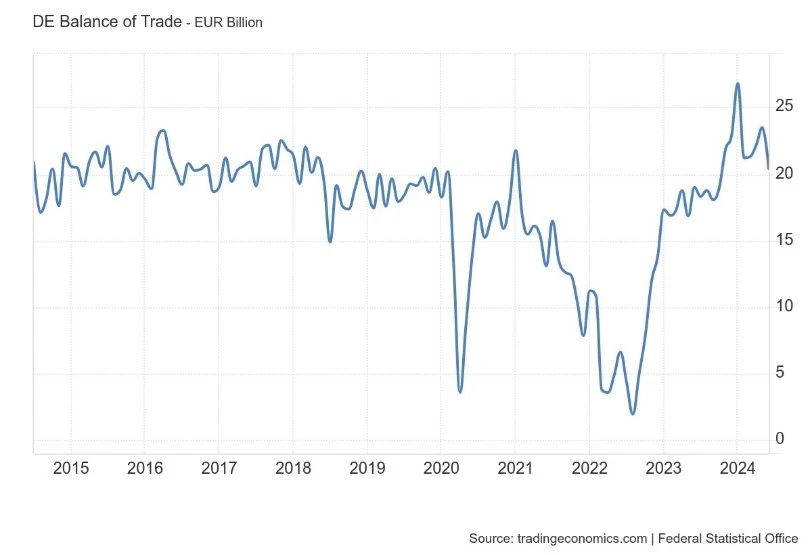
Goods exports are more or less flat; it’s imports that fell after the pandemic as German manufacturers cut back on production and the use of raw materials and components.
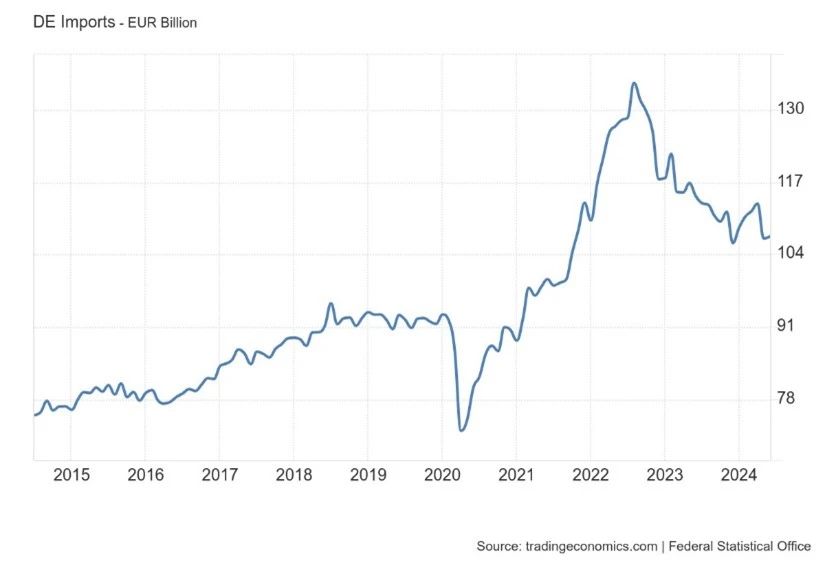
During the pandemic, government spending rose sharply to try and ameliorate the impact of job and wage losses. But once that ended, the coalition government applied fiscal austerity measures, supposedly to keep in line with EU Commission strictures and the German constitution that stipulates the state ‘may only spend as much money as it earns’.
Fiscal austerity measures applied since the pandemic
The government froze its climate and modernisation funding plans and plugged a €17bn ‘hole’ in its budget with austerity measures. This included scrapping a diesel subsidy for agricultural vehicles which set off angry protests by farmers. Tractors stormed cities and blocked off several autobahn junctions. The disruption to millions of commuters was exacerbated by a train drivers’ strike on a disintegrating privatized rail system.
To top it all, the finance minister Christian Lindner, who is the leader of the small neo-liberal ‘free market’ FDP party, is insisting on cutting social spending (particularly hammering those in eastern Germany). Lindner wants to cut government spending by up to €50 billion!
What all this shows is that even German capitalism, the most successful advanced capitalist economy in Europe, cannot escape the divisive forces of the Long Depression. But it is also shows that the German coalition government’s slavish following of the interests of US imperialism in the name of ‘Western democracy’ over Ukraine and Israel is destroying the hegemony of German capital and the living standards of its poorest citizens. No wonder the voices of nationalism and reaction are gaining traction.
From the blog of Michael Roberts. The original, with all charts and hyperlinks, can be found here.

